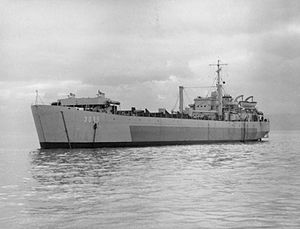Empire Fulmar was a LST (3) which was built in 1945 by Davie Shipbuilding & Repairing Co Ltd as HMS LST 3524 for the Royal Navy. She was renamed HMS Trumpeter in 1947. She was transferred to the Ministry of Transport in 1956 and renamed Empire Fulmar, serving in the Suez Crisis. She was later laid up in Singapore and was scrapped there in 1969.
 HMS LST 3035, an LST (3)
| |
| History | |
|---|---|
| Name |
|
| Owner |
|
| Operator |
|
| Port of registry |
|
| Ordered | 28 April 1944 |
| Builder | Davie Shipbuilding, Lauzon |
| Yard number | 571 |
| Launched | 25 July 1945 |
| Commissioned | 6 November 1945 |
| Fate | Scrapped 1969 |
| General characteristics | |
| Class and type | LST (3) |
| Tonnage | 4,267 GRT |
| Length |
|
| Beam | 55 ft 0 in (16.76 m) |
| Draught | 12 ft 0 in (3.66 m) maximum |
| Depth | 26 ft 4 in (8.03 m) |
| Installed power | Triple expansion steam engine, 1,500 IHP |
| Propulsion | Twin screw propellers |
| Speed | 13 knots (24 km/h) |
| Capacity |
|
| Crew | 115 |
Description
editThe ship was 330 ft 0 in (100.58 m) long between perpendiculars (347 ft 5 in (105.89 m) overall), with a beam of 55 ft 0 in (16.76400 m). She had a depth of 26 ft 4 in (8.03 m),[1] and a draught of 4 ft 5 in (1.35 m) forward in beaching mode and 12 ft 0 in (3.66 m) maximum.[2] She was assessed at 4,267 GRT.[3]
The ship was propelled by a triple expansion steam engine. The engine was built by the Canadian Pacific Railway. Rated at 1,500IHP, it drove twin screw propellers. The engine could propel the ship at a speed of 13 knots (24 km/h), but her normal cruising speed was 10 knots (19 km/h).[2] Fuel consumption was 40 tons per day at 9.5 knots (17.6 km/h).[1]
She had a complement of 115 officers and men, and could carry 168 troops, or 7 LCMs or 18 40-ton tanks or 27 trucks.[2]
History
editHMS LST 3524 was ordered on 28 April 1944.[4] She was built as yard number 571 in 1945 by Davie Shipbuilding & Repairing Co Ltd, Lauzon, Quebec, Canada.[5] She was launched on 25 July 1945.[4] In 1947, she was renamed HMS Trumpeter.[6] She was later laid up in the Clyde.[2]
In 1956, HMS Trumpeter was transferred to the Ministry of Transport and renamed Empire Fulmar[6] She was operated under the management of the Atlantic Steam Navigation Company.[3] She was used by the British Army as a ferry during the Suez Crisis.[2] In 1961, management was transferred to the British India Steam Navigation Company.[3] Empire Fulmar was involved in the British aid effort to Zambia in December 1965, carrying 2,200 drums of oil from Aden to Dar-es-Salaam, Tanzania.[7] She was laid up at Singapore in 1968.[2][6] Offered for sale in May 1968,[1] she was scrapped in January 1969.[4]
References
edit- ^ a b c "Ships for Sale". The Times. No. 57260. London. 25 May 1968. col C, p. 24.
- ^ a b c d e f "LST (Landing Ship Tank/Troop)". Luton & District Model Boat Club. Retrieved 22 May 2020.
- ^ a b c "Empire F". Mariners List. Retrieved 22 May 2020.
- ^ a b c "HMS LST 3524 (LST 3524)". Uboat. Retrieved 22 May 2020.
- ^ "Amphibious-Warfare Ships (LST) Built in WWII". Shipbuilding History. Retrieved 22 May 2020.
- ^ a b c Mitchell, W H, and Sawyer, L A (1995). The Empire Ships. London, New York, Hamburg, Hong Kong: Lloyd's of London Press Ltd. p. not cited. ISBN 1-85044-275-4.
{{cite book}}: CS1 maint: multiple names: authors list (link) - ^ "Royal Navy Brings in Oil Drums". The Times. No. 56512. London. 23 December 1956. col E, p. 8.